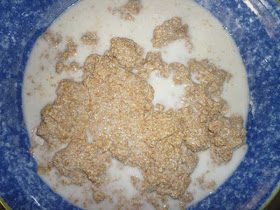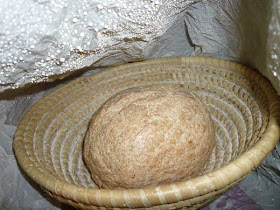Experimental Loaf
using whole wheat flour, rye sourdough, oat flour, kamut flour, and some boiled grains
Inspired by Nils Schöner's recipes (see the last post, a first attempt of his recipe for a 'German-style Sourdough') that incorporate so many seeds and other chunky cereal parts, I threw this experimental loaf together tonight to see what I might get.
I was also inspired by the latest 'Mother Earth News' (Dec 2010/January2011 issue) that had an article on bread making "Homemade Bread: Truly Easy and Delicious". The author of that magazine piece, William Rubel (author of a forthcoming book on bread), said a couple of things that intrigued me: for one thing, he said that he rarely measured anything, but let the dough tell him what it required. And he indicated that the dough must not be rushed.
This is interesting advice, but it makes a couple of assumptions that I can't always live with. For one thing, I measure things not to be picture perfect but to help me, if I ever do bake a really great loaf one day, so that I can duplicate the procedure. Secondly, the loaves that this author is talking about are enriched white wheat flour breads. Perhaps the author can be forgiven for making such an assumption: everyone else seems to make these kind of breads. But I am more interested in whole grains, and whole wheat is so very different from enriched white wheat flour, there is really little comparison. Secondly, I am also interested in other grains besides wheat. And each grain has its own characteristics. You can't 'go by the dough' if you've never worked with a grain before, because every grain is going to perform differently. Wheat and rye have gluten; a few other grains have some too, but not as much. So why would anyone use them in a bread?
Well, people sometimes use other grains because of the gluten: more and more people are discovering the dangers of gluten, and many people seem to have a sensitivity to it, some even have an allergy.
Besides, it is probably not a good thing for humans or for the world's environment to eat only a monoculture of one grain. If you do, you will lose out on the benefits of, for example, buckwheat's wonderful organic conditioning of the soil; or oat's amazing ability to lower cholesterol. Or the wide variety of micronutrients that are provided in differing quantities in other grains beside those with which we are so over-familiar.
It was, in fact, the idea of eating more oats in my diet that interested me about this particular combination of grains for my experimental loaf. I had some oat flour, and some steel cut oats; and I wanted to add this to some kamut flour. And I was going to use some whole wheat flour and some rye in the form of a sourdough, as well. I am, after all, not one of those who has a gluten sensitivity, as far as I know.
I had no idea how this particular combination would behave, so I decided to follow Nils' Schöner's basic schedule for his various rye sourdough raised loaves. I was using a lot more rye sourdough, but I was hoping that this might make up for some deficiencies in the gluten forming ability of the oat flour and the kamut.
Here are the ingredients I weighed:
- 2 c flour 316g
- some rye sourdough @ 100% hydration 511g
- 1 c oat flour 130g
- 1 c kamut flour 177g
- 1/2 c 8 grain cereal 52g
- 1/2 c steel cut oats 87g
- 1 c boiling water 231g
- 2 tsp sea salt 12g
- 1 3/8 c cold water 349g
Method:
Boil the water and stir in the 8 grain cereal and the steel cut oats. Bring to a boil, stir rapidly, then cover and remove from heat for 15 minutes.
Mix the remaining flours, and salt and sourdough and add the cold water, mixing as thoroughly as possible. I found I had the consistency I wanted when I had added 349g of water to my flour and sourdough mixture. Here I was just going by feel, like Rubel suggests.
When the boiled grains have cooled slightly, fold them into the mixture and pour it onto the counter top to knead until everything is well incorporated.
The first bulk fermentation is 30 minutes in a bowl.
Then fold it one more time and place it in a buttered tin.
Wait 1 1/2 hours, and preheat the oven to 450 degrees with a pan for steam.
At the 2 hour mark, the oven is hot enough.
Dock the loaf, coat it with some egg white, and place in the oven with a cup full of water to provide steam in the closed oven.
Bake for 20 minutes and then turn down the heat to 400 degrees. Bake for another 40 minutes, turning the loaf midway through the bake.
I was really quite amazed at the powerful oven spring that this loaf had. I didn't score it, but it blew itself apart.
Results:
The crumb is a little gummy: it could have used a longer and perhaps hotter bake. I may have stopped the baking prematurely as the egg white wash on top made it look browner than it truly was.
The crust is fine. The taste of the interior is somewhat unusual, and I'm thinking that it is the kamut that gives it this unnameable essence of flavour. Since the interior is still somewhat moist, toasting it seems to improve it. The steel cut oats and the 8 grain cereal that I boiled are completely lost in the taste: either I need more, or I need to use them as a soaker, not as a boiled ingredient.
Notes to Myself
- You are unlikely to make this combination of doughs precisely the same way ever again - mostly because of the excess of rye sourdough used.
- If you are just using up starter in these experiments, try once to make it with a different sourdough, too -- perhaps using the one you've been keeping now, refreshing weekly, for about a year, at 75% hydration.
- Make it with 20% more ingredients.
- Make it the same but don't roll it up as per the instructions, just fold it and stretch it and put it in the tin.
- Try scoring the loaf.
- Instead of boiling, try soaking the steel-cut oats overnight. And use more, lots more.




























































